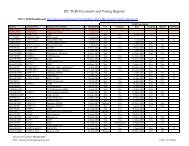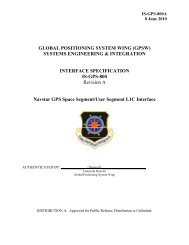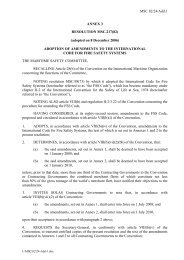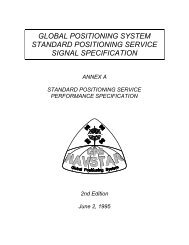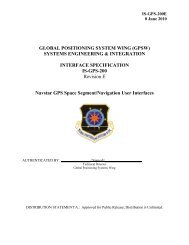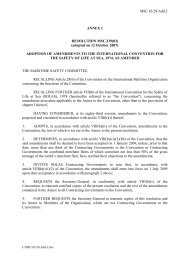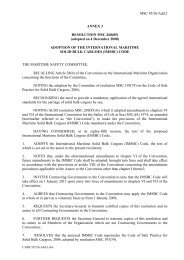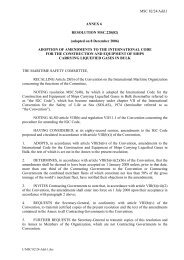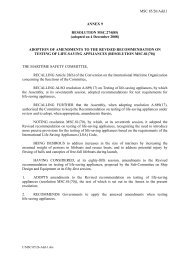The LORAN-C System - US Coast Guard Navigation Center
The LORAN-C System - US Coast Guard Navigation Center
The LORAN-C System - US Coast Guard Navigation Center
You also want an ePaper? Increase the reach of your titles
YUMPU automatically turns print PDFs into web optimized ePapers that Google loves.
Phase CodingWithin each pulse group from the master and secondary stations, thephase of the radio frequency (RF) carrier is changed systematicallyfrom pulse-to-pulse in the pattern shown in Figure II_8. This procedureis known as phase coding. <strong>The</strong> patterns “A” and “B” alternate insequence. <strong>The</strong> pattern of phase coding differs for the master andsecondary transmitters. Thus, the exact sequence of pulses is actuallymatched every two GRIs an interval known as a phase code interval(PCI). 9Phase coding enables the identification of the pulses in one GRI fromthose in an earlier or subsequent GRI. Just as selection of the pulseshape and standard zero crossing enable rejection of certain skywaves,phase coding enables rejection of others; late airway skywaves willhave a different phase code from the groundwave. Because the master andsecondary signals have different phase codes, these can bedistinguished by the loran receiver. Phase coding also offers othertechnical benefits.Blink Coding<strong>The</strong> Loran-C system also permits the secondary transmissions (morespecifically the first two pulses of the secondary pulse group) toblink.This secondary blink can be detected by the loran receiver, and isused to warn users that the loran signal is unreliable and should notbe used for navigation. (<strong>The</strong> specifics of the blink display differ fromreceiver-to-receiver in some cases a blink alarm on the receiver willlight, in others the displayed TDs simply blink on and off.) Blinkalarms warn that the signal power, TD, or ECD is out-of-tolerance (OOT)and/or that an improper phase code or GRI is being transmitted. <strong>The</strong>blink coding contributes significantly to the integrity of the loransystem.When secondary blink is enabled, the first two pulses of the affectedsecondary are blinked at a four-second cycle; about 3.6 seconds off andabout 0.4 seconds on. Secondary blink is used to advise users ofpotential problems. <strong>The</strong> loran system also has the capability to blinkthe master signal. Master blink is used for internal communications,and does not indicate a system malfunction. Most modern user receiversare not programmed to detect master blink.Concluding CommentsTable II_7 summarizes some of the key technical features of the Loran-Csystem and reasons for their inclusion. At a detailed level, thissystem is highly complex, but these complexities are essential tocreate a highly accurate, reliable, and easy to use long-range system.




